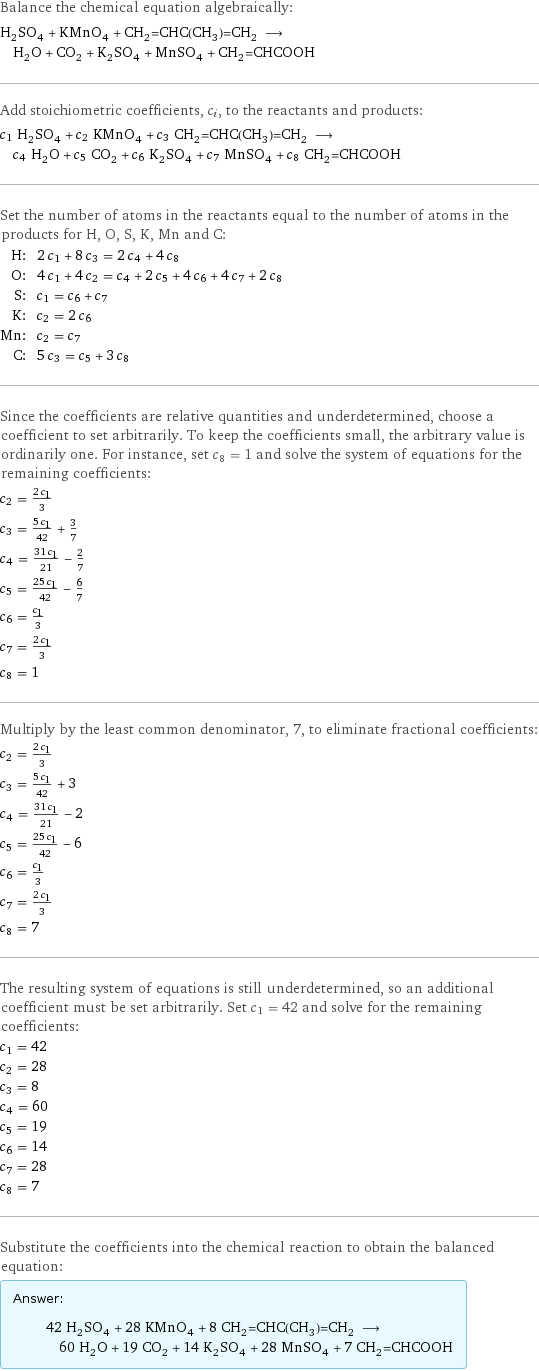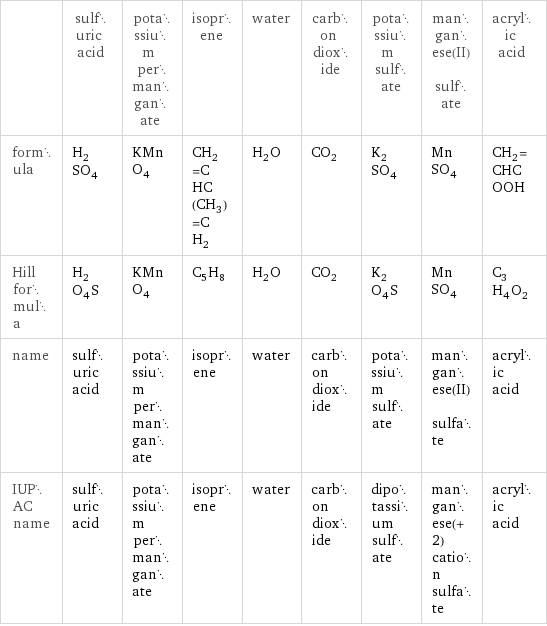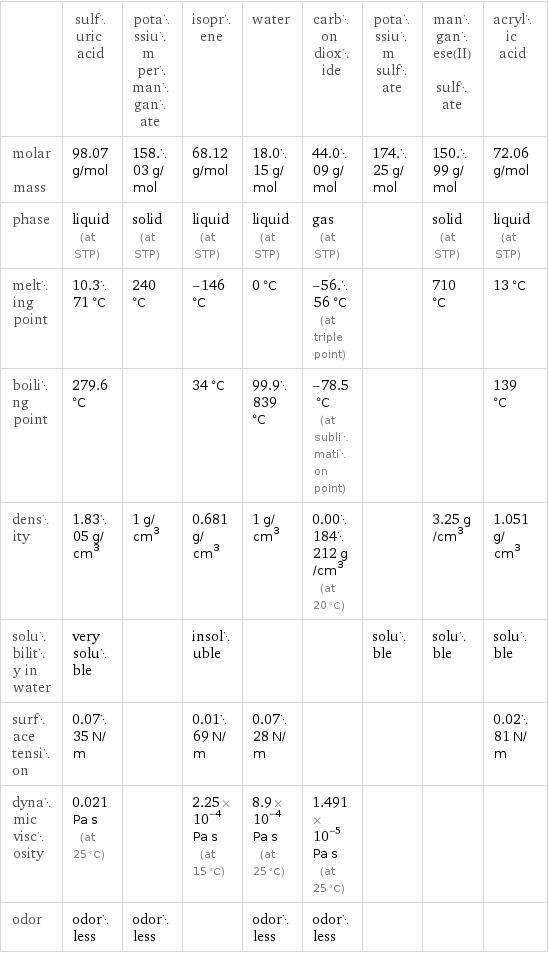Input interpretation

H_2SO_4 sulfuric acid + KMnO_4 potassium permanganate + CH_2=CHC(CH_3)=CH_2 isoprene ⟶ H_2O water + CO_2 carbon dioxide + K_2SO_4 potassium sulfate + MnSO_4 manganese(II) sulfate + CH_2=CHCOOH acrylic acid
Balanced equation

Balance the chemical equation algebraically: H_2SO_4 + KMnO_4 + CH_2=CHC(CH_3)=CH_2 ⟶ H_2O + CO_2 + K_2SO_4 + MnSO_4 + CH_2=CHCOOH Add stoichiometric coefficients, c_i, to the reactants and products: c_1 H_2SO_4 + c_2 KMnO_4 + c_3 CH_2=CHC(CH_3)=CH_2 ⟶ c_4 H_2O + c_5 CO_2 + c_6 K_2SO_4 + c_7 MnSO_4 + c_8 CH_2=CHCOOH Set the number of atoms in the reactants equal to the number of atoms in the products for H, O, S, K, Mn and C: H: | 2 c_1 + 8 c_3 = 2 c_4 + 4 c_8 O: | 4 c_1 + 4 c_2 = c_4 + 2 c_5 + 4 c_6 + 4 c_7 + 2 c_8 S: | c_1 = c_6 + c_7 K: | c_2 = 2 c_6 Mn: | c_2 = c_7 C: | 5 c_3 = c_5 + 3 c_8 Since the coefficients are relative quantities and underdetermined, choose a coefficient to set arbitrarily. To keep the coefficients small, the arbitrary value is ordinarily one. For instance, set c_8 = 1 and solve the system of equations for the remaining coefficients: c_2 = (2 c_1)/3 c_3 = (5 c_1)/42 + 3/7 c_4 = (31 c_1)/21 - 2/7 c_5 = (25 c_1)/42 - 6/7 c_6 = c_1/3 c_7 = (2 c_1)/3 c_8 = 1 Multiply by the least common denominator, 7, to eliminate fractional coefficients: c_2 = (2 c_1)/3 c_3 = (5 c_1)/42 + 3 c_4 = (31 c_1)/21 - 2 c_5 = (25 c_1)/42 - 6 c_6 = c_1/3 c_7 = (2 c_1)/3 c_8 = 7 The resulting system of equations is still underdetermined, so an additional coefficient must be set arbitrarily. Set c_1 = 42 and solve for the remaining coefficients: c_1 = 42 c_2 = 28 c_3 = 8 c_4 = 60 c_5 = 19 c_6 = 14 c_7 = 28 c_8 = 7 Substitute the coefficients into the chemical reaction to obtain the balanced equation: Answer: | | 42 H_2SO_4 + 28 KMnO_4 + 8 CH_2=CHC(CH_3)=CH_2 ⟶ 60 H_2O + 19 CO_2 + 14 K_2SO_4 + 28 MnSO_4 + 7 CH_2=CHCOOH
Structures

+ + ⟶ + + + +
Names

sulfuric acid + potassium permanganate + isoprene ⟶ water + carbon dioxide + potassium sulfate + manganese(II) sulfate + acrylic acid
Equilibrium constant
![Construct the equilibrium constant, K, expression for: H_2SO_4 + KMnO_4 + CH_2=CHC(CH_3)=CH_2 ⟶ H_2O + CO_2 + K_2SO_4 + MnSO_4 + CH_2=CHCOOH Plan: • Balance the chemical equation. • Determine the stoichiometric numbers. • Assemble the activity expression for each chemical species. • Use the activity expressions to build the equilibrium constant expression. Write the balanced chemical equation: 42 H_2SO_4 + 28 KMnO_4 + 8 CH_2=CHC(CH_3)=CH_2 ⟶ 60 H_2O + 19 CO_2 + 14 K_2SO_4 + 28 MnSO_4 + 7 CH_2=CHCOOH Assign stoichiometric numbers, ν_i, using the stoichiometric coefficients, c_i, from the balanced chemical equation in the following manner: ν_i = -c_i for reactants and ν_i = c_i for products: chemical species | c_i | ν_i H_2SO_4 | 42 | -42 KMnO_4 | 28 | -28 CH_2=CHC(CH_3)=CH_2 | 8 | -8 H_2O | 60 | 60 CO_2 | 19 | 19 K_2SO_4 | 14 | 14 MnSO_4 | 28 | 28 CH_2=CHCOOH | 7 | 7 Assemble the activity expressions accounting for the state of matter and ν_i: chemical species | c_i | ν_i | activity expression H_2SO_4 | 42 | -42 | ([H2SO4])^(-42) KMnO_4 | 28 | -28 | ([KMnO4])^(-28) CH_2=CHC(CH_3)=CH_2 | 8 | -8 | ([CH2=CHC(CH3)=CH2])^(-8) H_2O | 60 | 60 | ([H2O])^60 CO_2 | 19 | 19 | ([CO2])^19 K_2SO_4 | 14 | 14 | ([K2SO4])^14 MnSO_4 | 28 | 28 | ([MnSO4])^28 CH_2=CHCOOH | 7 | 7 | ([CH2=CHCOOH])^7 The equilibrium constant symbol in the concentration basis is: K_c Mulitply the activity expressions to arrive at the K_c expression: Answer: | | K_c = ([H2SO4])^(-42) ([KMnO4])^(-28) ([CH2=CHC(CH3)=CH2])^(-8) ([H2O])^60 ([CO2])^19 ([K2SO4])^14 ([MnSO4])^28 ([CH2=CHCOOH])^7 = (([H2O])^60 ([CO2])^19 ([K2SO4])^14 ([MnSO4])^28 ([CH2=CHCOOH])^7)/(([H2SO4])^42 ([KMnO4])^28 ([CH2=CHC(CH3)=CH2])^8)](../image_source/4b873b6ab9644e417e34335997832499.png)
Construct the equilibrium constant, K, expression for: H_2SO_4 + KMnO_4 + CH_2=CHC(CH_3)=CH_2 ⟶ H_2O + CO_2 + K_2SO_4 + MnSO_4 + CH_2=CHCOOH Plan: • Balance the chemical equation. • Determine the stoichiometric numbers. • Assemble the activity expression for each chemical species. • Use the activity expressions to build the equilibrium constant expression. Write the balanced chemical equation: 42 H_2SO_4 + 28 KMnO_4 + 8 CH_2=CHC(CH_3)=CH_2 ⟶ 60 H_2O + 19 CO_2 + 14 K_2SO_4 + 28 MnSO_4 + 7 CH_2=CHCOOH Assign stoichiometric numbers, ν_i, using the stoichiometric coefficients, c_i, from the balanced chemical equation in the following manner: ν_i = -c_i for reactants and ν_i = c_i for products: chemical species | c_i | ν_i H_2SO_4 | 42 | -42 KMnO_4 | 28 | -28 CH_2=CHC(CH_3)=CH_2 | 8 | -8 H_2O | 60 | 60 CO_2 | 19 | 19 K_2SO_4 | 14 | 14 MnSO_4 | 28 | 28 CH_2=CHCOOH | 7 | 7 Assemble the activity expressions accounting for the state of matter and ν_i: chemical species | c_i | ν_i | activity expression H_2SO_4 | 42 | -42 | ([H2SO4])^(-42) KMnO_4 | 28 | -28 | ([KMnO4])^(-28) CH_2=CHC(CH_3)=CH_2 | 8 | -8 | ([CH2=CHC(CH3)=CH2])^(-8) H_2O | 60 | 60 | ([H2O])^60 CO_2 | 19 | 19 | ([CO2])^19 K_2SO_4 | 14 | 14 | ([K2SO4])^14 MnSO_4 | 28 | 28 | ([MnSO4])^28 CH_2=CHCOOH | 7 | 7 | ([CH2=CHCOOH])^7 The equilibrium constant symbol in the concentration basis is: K_c Mulitply the activity expressions to arrive at the K_c expression: Answer: | | K_c = ([H2SO4])^(-42) ([KMnO4])^(-28) ([CH2=CHC(CH3)=CH2])^(-8) ([H2O])^60 ([CO2])^19 ([K2SO4])^14 ([MnSO4])^28 ([CH2=CHCOOH])^7 = (([H2O])^60 ([CO2])^19 ([K2SO4])^14 ([MnSO4])^28 ([CH2=CHCOOH])^7)/(([H2SO4])^42 ([KMnO4])^28 ([CH2=CHC(CH3)=CH2])^8)
Rate of reaction
![Construct the rate of reaction expression for: H_2SO_4 + KMnO_4 + CH_2=CHC(CH_3)=CH_2 ⟶ H_2O + CO_2 + K_2SO_4 + MnSO_4 + CH_2=CHCOOH Plan: • Balance the chemical equation. • Determine the stoichiometric numbers. • Assemble the rate term for each chemical species. • Write the rate of reaction expression. Write the balanced chemical equation: 42 H_2SO_4 + 28 KMnO_4 + 8 CH_2=CHC(CH_3)=CH_2 ⟶ 60 H_2O + 19 CO_2 + 14 K_2SO_4 + 28 MnSO_4 + 7 CH_2=CHCOOH Assign stoichiometric numbers, ν_i, using the stoichiometric coefficients, c_i, from the balanced chemical equation in the following manner: ν_i = -c_i for reactants and ν_i = c_i for products: chemical species | c_i | ν_i H_2SO_4 | 42 | -42 KMnO_4 | 28 | -28 CH_2=CHC(CH_3)=CH_2 | 8 | -8 H_2O | 60 | 60 CO_2 | 19 | 19 K_2SO_4 | 14 | 14 MnSO_4 | 28 | 28 CH_2=CHCOOH | 7 | 7 The rate term for each chemical species, B_i, is 1/ν_i(Δ[B_i])/(Δt) where [B_i] is the amount concentration and t is time: chemical species | c_i | ν_i | rate term H_2SO_4 | 42 | -42 | -1/42 (Δ[H2SO4])/(Δt) KMnO_4 | 28 | -28 | -1/28 (Δ[KMnO4])/(Δt) CH_2=CHC(CH_3)=CH_2 | 8 | -8 | -1/8 (Δ[CH2=CHC(CH3)=CH2])/(Δt) H_2O | 60 | 60 | 1/60 (Δ[H2O])/(Δt) CO_2 | 19 | 19 | 1/19 (Δ[CO2])/(Δt) K_2SO_4 | 14 | 14 | 1/14 (Δ[K2SO4])/(Δt) MnSO_4 | 28 | 28 | 1/28 (Δ[MnSO4])/(Δt) CH_2=CHCOOH | 7 | 7 | 1/7 (Δ[CH2=CHCOOH])/(Δt) (for infinitesimal rate of change, replace Δ with d) Set the rate terms equal to each other to arrive at the rate expression: Answer: | | rate = -1/42 (Δ[H2SO4])/(Δt) = -1/28 (Δ[KMnO4])/(Δt) = -1/8 (Δ[CH2=CHC(CH3)=CH2])/(Δt) = 1/60 (Δ[H2O])/(Δt) = 1/19 (Δ[CO2])/(Δt) = 1/14 (Δ[K2SO4])/(Δt) = 1/28 (Δ[MnSO4])/(Δt) = 1/7 (Δ[CH2=CHCOOH])/(Δt) (assuming constant volume and no accumulation of intermediates or side products)](../image_source/31257fcacbe7f60a3db31e9a08734ade.png)
Construct the rate of reaction expression for: H_2SO_4 + KMnO_4 + CH_2=CHC(CH_3)=CH_2 ⟶ H_2O + CO_2 + K_2SO_4 + MnSO_4 + CH_2=CHCOOH Plan: • Balance the chemical equation. • Determine the stoichiometric numbers. • Assemble the rate term for each chemical species. • Write the rate of reaction expression. Write the balanced chemical equation: 42 H_2SO_4 + 28 KMnO_4 + 8 CH_2=CHC(CH_3)=CH_2 ⟶ 60 H_2O + 19 CO_2 + 14 K_2SO_4 + 28 MnSO_4 + 7 CH_2=CHCOOH Assign stoichiometric numbers, ν_i, using the stoichiometric coefficients, c_i, from the balanced chemical equation in the following manner: ν_i = -c_i for reactants and ν_i = c_i for products: chemical species | c_i | ν_i H_2SO_4 | 42 | -42 KMnO_4 | 28 | -28 CH_2=CHC(CH_3)=CH_2 | 8 | -8 H_2O | 60 | 60 CO_2 | 19 | 19 K_2SO_4 | 14 | 14 MnSO_4 | 28 | 28 CH_2=CHCOOH | 7 | 7 The rate term for each chemical species, B_i, is 1/ν_i(Δ[B_i])/(Δt) where [B_i] is the amount concentration and t is time: chemical species | c_i | ν_i | rate term H_2SO_4 | 42 | -42 | -1/42 (Δ[H2SO4])/(Δt) KMnO_4 | 28 | -28 | -1/28 (Δ[KMnO4])/(Δt) CH_2=CHC(CH_3)=CH_2 | 8 | -8 | -1/8 (Δ[CH2=CHC(CH3)=CH2])/(Δt) H_2O | 60 | 60 | 1/60 (Δ[H2O])/(Δt) CO_2 | 19 | 19 | 1/19 (Δ[CO2])/(Δt) K_2SO_4 | 14 | 14 | 1/14 (Δ[K2SO4])/(Δt) MnSO_4 | 28 | 28 | 1/28 (Δ[MnSO4])/(Δt) CH_2=CHCOOH | 7 | 7 | 1/7 (Δ[CH2=CHCOOH])/(Δt) (for infinitesimal rate of change, replace Δ with d) Set the rate terms equal to each other to arrive at the rate expression: Answer: | | rate = -1/42 (Δ[H2SO4])/(Δt) = -1/28 (Δ[KMnO4])/(Δt) = -1/8 (Δ[CH2=CHC(CH3)=CH2])/(Δt) = 1/60 (Δ[H2O])/(Δt) = 1/19 (Δ[CO2])/(Δt) = 1/14 (Δ[K2SO4])/(Δt) = 1/28 (Δ[MnSO4])/(Δt) = 1/7 (Δ[CH2=CHCOOH])/(Δt) (assuming constant volume and no accumulation of intermediates or side products)
Chemical names and formulas

| sulfuric acid | potassium permanganate | isoprene | water | carbon dioxide | potassium sulfate | manganese(II) sulfate | acrylic acid formula | H_2SO_4 | KMnO_4 | CH_2=CHC(CH_3)=CH_2 | H_2O | CO_2 | K_2SO_4 | MnSO_4 | CH_2=CHCOOH Hill formula | H_2O_4S | KMnO_4 | C_5H_8 | H_2O | CO_2 | K_2O_4S | MnSO_4 | C_3H_4O_2 name | sulfuric acid | potassium permanganate | isoprene | water | carbon dioxide | potassium sulfate | manganese(II) sulfate | acrylic acid IUPAC name | sulfuric acid | potassium permanganate | isoprene | water | carbon dioxide | dipotassium sulfate | manganese(+2) cation sulfate | acrylic acid
Substance properties

| sulfuric acid | potassium permanganate | isoprene | water | carbon dioxide | potassium sulfate | manganese(II) sulfate | acrylic acid molar mass | 98.07 g/mol | 158.03 g/mol | 68.12 g/mol | 18.015 g/mol | 44.009 g/mol | 174.25 g/mol | 150.99 g/mol | 72.06 g/mol phase | liquid (at STP) | solid (at STP) | liquid (at STP) | liquid (at STP) | gas (at STP) | | solid (at STP) | liquid (at STP) melting point | 10.371 °C | 240 °C | -146 °C | 0 °C | -56.56 °C (at triple point) | | 710 °C | 13 °C boiling point | 279.6 °C | | 34 °C | 99.9839 °C | -78.5 °C (at sublimation point) | | | 139 °C density | 1.8305 g/cm^3 | 1 g/cm^3 | 0.681 g/cm^3 | 1 g/cm^3 | 0.00184212 g/cm^3 (at 20 °C) | | 3.25 g/cm^3 | 1.051 g/cm^3 solubility in water | very soluble | | insoluble | | | soluble | soluble | soluble surface tension | 0.0735 N/m | | 0.0169 N/m | 0.0728 N/m | | | | 0.0281 N/m dynamic viscosity | 0.021 Pa s (at 25 °C) | | 2.25×10^-4 Pa s (at 15 °C) | 8.9×10^-4 Pa s (at 25 °C) | 1.491×10^-5 Pa s (at 25 °C) | | | odor | odorless | odorless | | odorless | odorless | | |
Units
